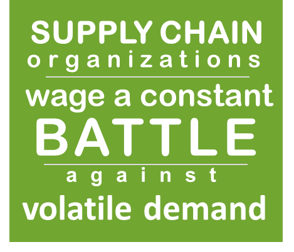Inventory supply has a mutable nature, and can shift based upon demand, competition, trends and weather. Inventory management is critical. According to a 2014 Business Forward Foundation report, in the American automobile industry, “auto-makers penalize suppliers as much as $10,000 for every minute their shipments are late. Faced with these penalties, a supplier whose trucks are delayed will  often hire a helicopter to deliver a substitute shipment.” Imagine the costs that can be accrued. Stock-outs can be devastating, but excess inventory is not a solution. How does a company manage risk while still meeting the needs of customers?
often hire a helicopter to deliver a substitute shipment.” Imagine the costs that can be accrued. Stock-outs can be devastating, but excess inventory is not a solution. How does a company manage risk while still meeting the needs of customers?
What can be challenging is getting all of the moving parts and all of the stake-holders in the supply chain to align. In a Harvard Business Review article V.G. Narayanan and Ananth Raman wrote, “the fates of all supply chain members are interlinked: If the companies work together to efficiently deliver goods and services to consumers, they will all win. If they don’t, they will all lose to another supply chain. The challenge is to get all the firms in your supply network to play the game so that everybody wins. The only way you can do that is by aligning incentives.”
Volatility in the supply chain, and its impact on and response to inventory, weighs heavily on many companies. According to a 2011 McKinsey report on building the supply chain for the future, its authors stated, “Supply chain organizations wage a constant battle against volatile demand, and for good reason. An unexpected spike in orders, for example, has expensive consequences in labor and distribution costs. Similarly, inaccurate sales forecasts can lead to stock-outs, lost sales, or excess inventory that must be sold at a discount.” The same report showed that one of the top concerns of company executives regarding supply chain management is “the increasing volatility of customer demand.”
SYMPTOMS
The symptoms of excess inventory are numerous. The blaring truth is that the sale of inventory is critical to a company’s bottom line and growth. In order to maintain high profit margins, businesses need to turn over inventory quickly. The longer inventory is held the more expensive it becomes. With high inventory there’s the need for space to hold it, people to manage it, and insurance to protect it from expiration, thieves, and damage. Storage, labor, and insurance are costly. Selling excess materials at a discount in order to move the inventory is never ideal. If the inventory never sells a company can accrue high waste management costs. The quicker the inventory turns over the better.
SOLUTIONS
So how does a company balance increasing customer demand with the downfalls of excess inventory?
Perhaps the largest documented benefit of implementing a supplier eKanban is elimination of excess inventory. Organizations that switched from push or forecast-based material replenishment to pull-based material replenishment supported by supplier eKanban systems routinely see inventory reductions of 20-75%. The impact is not only financial. The EPA cites Kanban systems as critical tools to streamline production and alleviate the unnecessary storage of overstock, which drains electricity in the form of lighting, air conditioning, and heating. eKanban systems reduce the use of raw materials, emissions, and other manufacturing waste.
The companies who can find the right balance in their inventory holdings will reap many benefits. “In our industry,” says Jim Owens, the former chairman and CEO of construction-equipment maker Caterpillar, “the competitor that’s best at managing the supply chain is probably going be the most successful competitor over time. It’s a condition of success.”



